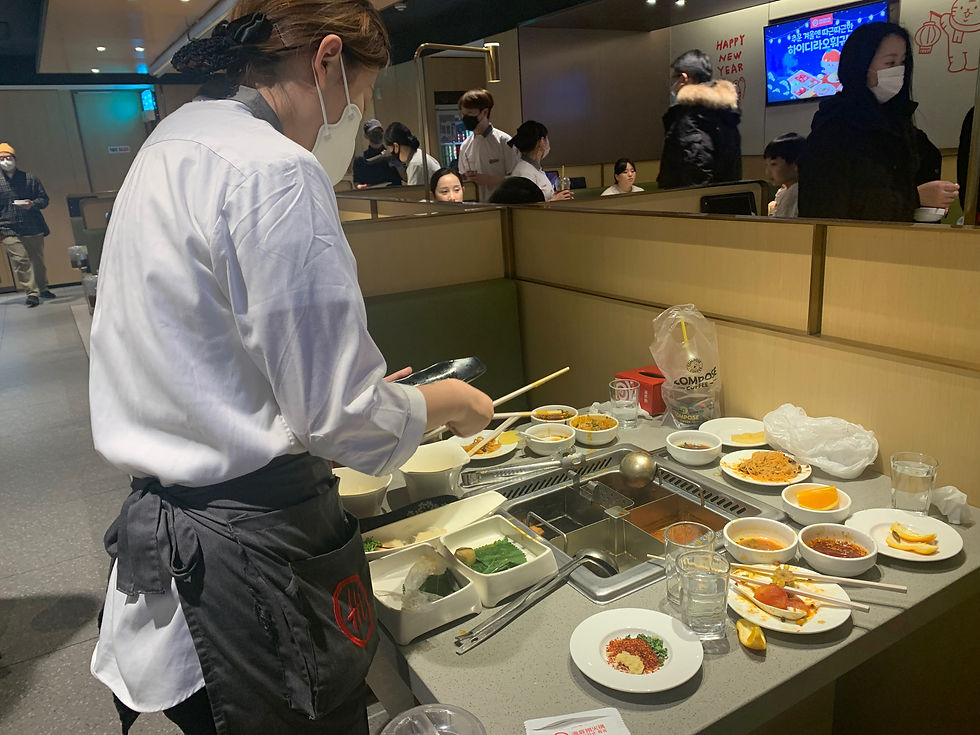Shortage of restaurant part-timers in South Korea
- 창완유[ 학부재학 / 미디어학부 ]
- Dec 11, 2022
- 3 min read
Updated: Dec 12, 2022
December 11, 2022
Henan Sun, Wenna Zhang
SEOUL - Korean restaurants are now struggling to find part-time workers. Even though the hourly rate has been raised to a high level, young people are reluctant to volunteer for the job. More seriously, due to the shortage of part-timers, some restaurants have to close.
According to data provided by Mediawill Networks Inc., the number of job postings registered in the first quarter of this year reached 2.42 million, up by 69 percent from last year.
After the lockdown, as people begin to return to dining in restaurants, the need for part-time workers is growing. However, many are reluctant to work as part-timers, especially in restaurants.
“It is difficult for me to find a part-timer, especially after the pandemic. Although it is true that if we give a higher hourly wage, such as 30,000 KRW, there must be someone who volunteers, but it is unrealistic to offer such a higher wage,” said Park Kyungbin, owner of Robert Chicken.

Restaurant-lined street in Daehak-ro bustles with people.

Job ads posted on the door in Anam Street.
Korea University Professor, Lee Jong Sun, who lectures on Unemployment and Employment Policy at the Department of Sociology, explains the reasons for shortage of part-timers in restaurants.
“Split part-time jobs(쪼개기 알바) causes the problem.”
Split part-time jobs refer to the circumstance in which part-timers work four hours a day and three days a week. Based on the Labor Standards Act, if part-timers’ working time is less than 15 hours a week, there is no legal obligation for owners to pay weekly allowances, social insurance and retirement allowances for them.
“The rising labor cost causes the growing trend of split part-time jobs. However, since the working hours of one worker decrease, restaurants need more workers, and worker shortage happens. On the other hand, part-timers cannot earn as much salary as before, so they choose to work as a delivery man which offers a higher salary and requires little customer interaction.” Professor Lee added.

Korea University’s Labor Studies Center

Elderly waitress serving in restaurants due to the lack of young part-timers.
A waiter of Haidilao Hotpot, who declined to be unidentified, said although he never heard of Split part-time jobs, there is a similar policy in Haidilao. If a worker who works for more than a year wants to retire from Haidilao, a month’s salary will be paid as retirement allowances. However, in order to not to pay extra salary to retired workers, Haidilao will force them to quit their work before they complete a full year of work, which makes part-timers feel discontent with Haidilao.

A part-timer was cleaning the table for customers.
According to the data provided by Mediawill Networks Inc., the two main reasons for worker shortage are “people who apply for the job are decreasing (78.9%)”, and “people quit their job soon (70.2%).
Park Kyungbin, the owner of Robert Chicken, agreed with the reason and added, “Many part-timers only work for a few weeks, and they always suddenly said they are going to leave the job after the week without telling me ahead of time.”
A statistics Catch Clue publicized showed that only 4 percent participants prefer to work in restaurants, while 31.8% prefer to work in coffee shops and 14.7% in convenience stores.
“I would like to work in a coffee shop if there is an opportunity,” stated Kim Jeeyeon, a part-timer in a pub, “With the same salary, I can do an easier job and have more time for myself in a convenience shop or coffee shop. Also, I only need to focus on my work and don’t need to talk with customers.”

A Part-timer is asked to give a performance in a restaurant.

Part-timer in CU using a phone when there are no customers.
Under a sudden increase in the demand for workers in the restaurants, a variety approaches are used to overcome the shortage of part-timers.
Robot Chicken’s chicken-frying-robot is one of the approaches. It has a robot arm hanging in the kitchen, which can automatically complete the whole process of cooking a fried chicken.
“Without the robot, I have to constantly flip the chicken in oil to create a crisp surface. It is kind of dangerous,” said Park Kyungbin. “Moreover, the robot has reduced the demand for part-timers in our shop. However, expect for cooking, robot cannot replace everything.”

The usage of chicken-frying-robot to reduce the demand for part-timers.
Although raising the salary and the usage of robots can help owners survive the restaurant industry part-timer shortage temporarily, they are costly. Therefore, further changes, including establishment of related services which offer part-time job opportunities to students in colleges and improved employment policy formulated by the government, are required.



Comments